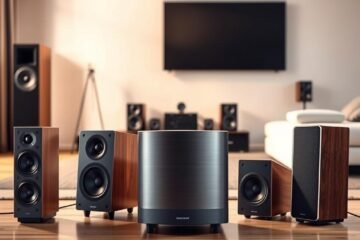Are you an audiophile on a budget? You don’t have to spend a lot to enjoy premium Hi-Fi sound. This guide will help you create a Budget Hi-Fi Audio System Under 300 in 2025. It will give youcrystal-clear sound, deep bass, and an immersive audio experience without spending too much.
We’ll explore essential components for your Hi-Fi setup. You’ll find top picks for budget-friendly speakers and amplifiers.
This guide shows you how to make an affordable audio system with clearhighs, deep bass, and full sound—all for less money.
Whether you’re upgrading or starting from scratch, a budget-friendly hifi system can change how you listen to music. We’ve gathered advice from What Hi-Fi?, Wirecutter, and TechRadar. They help you pick the right parts, from speakers to DACs, so you don’t spend too much.

Key Takeaways
- Build a high-quality system for under $300 using expert-recommended gear.
- Learn to balance affordability with performance using top-rated components.
- Discover how speaker choice and amplifier pairing maximize sound quality.
- Save money without compromising on features like wireless connectivity or portability.
- Follow step-by-step guidance to assemble a system tailored to your listening preferences.
Are you searching for a top-notch audio system on a budget? This guide will show you how to create a high quality system without spending too much. You’ll find affordable options that offer great sound quality. Experts say to focus on compatibility and performance for the best value.
Why Build a Budget-Friendly Hi-Fi System?
A budget system lets you enjoy great sound without spending a lot. Systems like the Yamaha YSP-5600 or Pioneer S-XP100 provide clear and powerful sound at a lower price. Making smart choices in components means you can upgrade later without having to replace everything.
Overview of This Guide’s Structure
- Section 3 explains core components and their roles in sound quality.
- Section 5 reviews top speaker options for different spaces.
- Section 7 details placement tips for optimal acoustics.
- Section 10 focuses on component compatibility and value.
Each section gives you practical steps to avoid common pitfalls. Follow this guide to build a system that fits your space and budget perfectly.
Understanding the Budget Hi-Fi Audio System Under 300 in 2025
Creating an affordable audio equipment setup under $300 needs careful choices. A budget-friendly sound system must balance cost, performance, and how well its parts work together. Experts say it’s key to pick parts that are compatible, sound clear, and offer good value over time.
- Compatibility: Speakers, amps, and DACs must work together to avoid mismatched power or impedance.
- Performance: Look for models with clear midrange tones and acceptable bass response for most rooms.
- Value: Prioritize systems where core components (speakers and amps) account for 60–70% of the budget.

“A $300 system shouldn’t mean compromised audio basics. Focus on brands like Yamaha or Edifier that optimize drivers and crossovers within this price range.” — SoundStage!, 2024 Review Roundup
Real-world testing shows top performers like the Edifier R1280DB achieve 85dB sensitivity—close to premium systems—despite their budget tags. User reviews confirm that prioritizing speaker quality over flashy features delivers better listening experiences. Always check impedance specs: 8Ω speakers pair better with most amplifiers in this price bracket.
Selecting a budget-friendly sound system requires evaluating trade-offs. While DACs and premium cables add cost, starting with core components first ensures foundational sound quality. Every dollar spent should enhance clarity, not just aesthetics.
Components of a Hi-Fi Audio System: Speakers, Amplifiers, DACs & Accessories
Choosing the right parts makes a cheap hi-fi audi system powerful. Let’s see how each part helps your setup sound great.
Speakers: Bookshelf vs. Floor-standing
Bookshelf speakers are small and fit well in tight spaces. They’re great for small rooms. On the other hand, floor-standing speakers give deeper bass but need more room.
TechRadar loves the KEF Q150 bookshelf speakers for their clear sound. What Hi-Fi? recommends the PSB Imagine T3 floor-standing speakers for their balanced sound.
| Category | Bookshelf | Floor-standing |
| Size | Compact | Larger |
| Best For | Small rooms | Large spaces |
| Price Range | $80–$200 | $150–$500 |
| Example | KEF Q150 | PSB Imagine T3 |
Amplifiers: Why They’re Essential for Better Sound
An amplifier boosts power for speakers to perform at their best. The Yamaha A-S501 (under $200) is praised for its clear highs and deep bass in budget audio system reviews.
DAC: Do You Really Need One?
A DAC converts digital signals to analog. If your device lacks a high-quality output, add a DAC like the FiiO K3. TechRadar calls it a “game-changer” for streaming services.
Budget-Friendly Cables & Accessories
Quality cables avoid signal loss.
- Monoprice interconnects ($15–$30)
- AudioQuest’s entry-level speaker cables
Make sure connections last without breaking your budget.
Exploring Best Budget Speakers Under 300 in 2025
Choosing the right speakers is key to building an affordable hi-fi audio system. These three options deliver rich sound quality at under $300. They balance cost with performance, each with unique features for different listening needs.

Top 3 Affordable Hi-Fi Speakers
- ELAC Debut 2.0 B6.2: 1-inch silk-dome tweeter and 6.5-inch aramid-fiber woofer. It delivers crisp highs and clear mids with deep bass without a subwoofer.
- Polk Audio Signature S20: 6.5-inch polypropylene cone drivers with a rear-ported design. It excels in detailed highs and dynamic midrange for music and movies.
- Q Acoustics 3020i: 4.9-inch drivers in curved cabinets. It has a warm tonal balance and spacious soundstage in compact form factors.
Pros & Cons of Each Option
ELAC Debut 2.0 B6.2
- Pros: Detailed soundstage, accurate treble, no subwoofer needed
- Cons: Requires powerful amplifiers, bulky design
“The B6.2’s clarity in vocals and instrumental separation outperform its price range.” – TechRadar
Polk Audio Signature S20
- Pros: Versatile for music/movie playback, sleek modern design
- Cons: Placement-sensitive due to rear ports, limited bass at high volumes
Q Acoustics 3020i
- Pros: Compact size for small rooms, smooth tonal balance
- Cons: Bass output drops at loud volumes, less impactful on rock/classical genres
These speakers show that a value-for-money audio system starts with smart speaker choices. Match their specs to your setup’s needs and amplifier compatibility for optimal results.
Affordable Amplifiers for Superior Hi-Fi Sound
An amplifier is key to your audio system, making weak signals sound rich. For a budget-friendly setup, the right amplifier lets your speakers shine. The Pioneer SX-10AE, with 100W per channel, is a Wirecutter favorite. It pairs well with budget speakers to enhance clarity and bass. Let’s look at how to pick an amplifier that’s just right for your system.
| Model | Power | Key Features |
|---|---|---|
| Pioneer SX-10AE | 100W/ch | Bluetooth, phono input, 7-inch vinyl support |
| Yamaha A-S301BL | 60W/ch | ToP-ART design, phono stage, digital inputs |
| Cambridge AXA35 | 35W/ch | Integrated DAC, minimalist design |
| Denon PMA-600NE | 45W/ch | Bluetooth, phono input, multi-source support |
Top Budget-Friendly Amplifier Options
These amplifiers offer top-notch sound without breaking the bank. The Yamaha A-S301BL has advanced circuitry for clear sound. The Cambridge AXA35 comes with a DAC for digital streaming. Each model strikes a balance between power and features for different setups.
Selecting the Perfect Amplifier for Your Setup
Here’s how to choose the right amplifier:
- Match power output to your speakers’ impedance for clarity
- Choose Bluetooth or phono inputs based on your listening habits
- Verify compatibility with existing DACs and speaker brands
Pairing the Onkyo A-9010 with bookshelf speakers or the Rotel A12 with floorstanders ensures great synergy. Look for features like gold-plated connectors to reduce signal loss. Always check reviews to find an amplifier that matches your budget-friendly hi-fi speakers without overspending.
Speaker Placement & System Setup for Optimal Performance
To get the best from your top rated low-cost audio system, start with smart placement and connections. Even the best parts need careful setup for clear sound. Follow these steps to make your affordable hi-fi setup sound great without spending more.

Positioning Your Speakers for Best Sound
Create a soundstage that fills your room by following these steps:
- Form an equilateral triangle: Place speakers 3–5 feet apart, angled toward your listening spot.
- Avoid wall corners—place speakers 1–2 feet away from walls to reduce bass buildup.
- Match speaker height to ear level when seated.
Connecting Your Amplifier, DAC, and Speakers
Ensure seamless integration with these connection steps:
- Power down all components before plugging cables.
- Connect DAC to amplifier first, then speakers to amplifier terminals.
- Use shielded cables to minimize interference.
Common issues like muffled bass or uneven volume often come from poor placement or tangled wiring. Test your setup by playing familiar tracks to spot gaps. Adjust speaker angles or distances gradually until dialogue and music sound natural. Proper setup can make even budget gear sound like more expensive systems.
Tuning Your Sound: Adjusting Settings for Best Performance
Getting the most out of your budget audiophile system is easy. Even entry-level gear like the Yamaha R-N502 or NAD C 366BEE can sound like a studio with a few tweaks. Start by adjusting your equalizer. Most systems come with presets like “Flat” or “Vocal” that match What Hi-Fi?’s suggestions.
- First, set your equalizer to default settings. If your room sounds too boomy, add 1-2dB to the bass.
- For clearer vocals, add 1-2dB to midrange frequencies (200-5000Hz).
- Use room calibration features, like the Oppo Sonica app, for automatic adjustments.
DIY acoustic tweaks can enhance your system without breaking the bank. Try placing egg crate foam panels behind your speakers or use bookshelves as bass traps. But avoid these common mistakes:
- Don’t place speakers too close to walls (it causes resonance).
- Make sure left and right channels are in phase.
- Avoid extreme EQ boosts or cuts.
“A 2-3dB level difference between channels can ruin stereo imaging,” warns audiologist Sarah Lin in SoundStage’s 2024 guide.
Test tracks like Lianne La Havas’ “Trouble” can show tonal imbalances. Make small adjustments and test again. Your ears are the best judge.
What Makes a Great Budget Hi-Fi Audio System under 300 in 2025?
An inexpensive hi-fi sound system that performs well has three key traits. These are clear sound, parts that work well together, and smart spending. Let’s see how these traits come together to make a great setup.
- Sound Quality First: The Wharfedale Diamond 12.1 shows that you don’t need to spend a lot for great sound. It has clear highs and deep bass.
- Component Synergy: The Cambridge Audio AXR85 amplifier and Triangle Borea BR03 speakers together show how matching parts can improve sound without breaking the bank.
- Value-Driven Choices: Look for systems like the KEF Q150. They offer great sound at a fair price, avoiding the trap of overpaying for “budget” options.
Experts at What Hi-Fi? say the best affordable hi-fi audio equipment doesn’t cut corners on sound quality. For example, the KEF Q150 has a small design but big sound. When shopping, choose brands known for quality, like Wharfedale or Cambridge Audio. This ensures your system lasts long and works well.
A great system is more than just its parts. It’s how they work together. Always test how well parts fit before you buy. For example, pairing a 50W amplifier with speakers that need 80W prevents them from not working well together. This way, every dollar you spend makes your music listening better.
Matching Audio Components: Ensuring Compatibility and Value
To create the best budget audio system 2025, you need more than just parts. They must work together for clear sound without problems. Make sure speakers, amplifiers, and DACs are compatible to get the most out of your setup.
“A well-matched system turns affordable gear into a listening experience that rivals pricier setups.” – Hi-Fi Choice Magazine
Choosing the Right Components
Start by looking at technical specs. Match inexpensive hi-fi speakers with amplifiers that fit their impedance ratings. For instance, an 8Ω speaker needs an amp with at least 50W RMS. Brands like Yamaha and PSB have systems tested for compatibility. Here’s how to proceed:
- Compare sensitivity ratings (89dB+ for efficient speakers)
- Verify amplifier wattage vs. speaker power handling
- Use manufacturer compatibility charts for DAC and cable pairings
Balancing Sound Quality and Affordability
Don’t trade off quality for price. The KEF LS50 Wireless II shows inexpensive hi-fi speakers can offer top-notch sound with the right amplifier. Spend 40-50% of your budget on speakers, as they set the tone. Check out AVS Forum for mid-range component comparisons.
Compatibility isn’t just about tech specs; it’s also about your listening preferences. Bass lovers might focus on subwoofer compatibility, while jazz fans care more about midrange clarity. Use free impedance calculators and read What Hi-Fi? reviews to ensure each part enhances your sound without breaking the bank.
Enhancing Your Audio Experience on a Budget
Even the best cheap high fidelity audio gear can shine brighter with smart upgrades. These tweaks maximize performance without overspending. They turn your affordable audio system for under 300 into a standout setup.
Additional DIY Tricks to Boost Performance
Small adjustments can yield big results:
- Ferrite cores on power and audio cables block interference. Slide them onto cables near components to cut high-frequency noise.
- Use anti-vibration pads to decouple speakers from floors. Brands like IsoAcoustics or DIY solutions like rubber washers stacks reduce bass muddiness.
- Protect electronics with Sorbothane pads. Place under turntables or tube amps to dampen micro-vibrations—try Sorbothane pads at under $20.
- Swap cables for shielded options like Belden 89250 to block EMI. DIY cable builders can use LAPP shielding sleeves for under $10.
Fine-Tuning Your System for Maximum Impact
Adjust settings and placement for peak performance:
- Power conditioning: Plug components into a Tacima mains conditioner. Add an iFi AC iPurifier to a separate outlet for extra noise suppression.
- Optimize speaker placement with setup CDs or apps like Room EQ Wizard. Aim for symmetrical spacing and toe-in angles.
- Clean connectors quarterly with contact cleaners like DeoxIT. Oxidation buildup can degrade signal paths over time.
These steps turn entry-level gear into a polished system. Prioritize one tweak at a time to hear differences clearly.
Conclusion: Enjoy High-Quality Sound for Less
Creating a budget-friendly hi-fi setup doesn’t mean you have to give up on sound quality. The low-cost hi-fi audio components we’ve looked at show that you can get great sound without spending a lot. By choosing the right components and being smart with your budget, you can make a system that sounds amazing without breaking the bank.
Sonos models like the Era 100 (at $249) and Beam Gen 2 offer top-notch features at prices that are easy on the wallet. And when sales come around, you can save even more. Adding small touches like using Sorbothane pads or ferrite cores can make a big difference. Even simple steps like grounding your system and cleaning your cables can improve sound quality.
Getting your setup right is key. Place your speakers in a way that sounds good, avoid walls, and use tools like Nordost’s Eco 3X to manage static. Every little change, from how you route cables to how you set up your room, helps make your sound clearer and more immersive. With these tips, you can turn basic components into something that sounds like it cost a lot more.
Invest in the important parts like amplifiers and DACs, then add affordable upgrades. By following this guide, you can make a system that’s both affordable and high-quality. Whether you’re listening to music or watching movies, the right choices mean you can enjoy top-notch sound without spending too much. Start building your setup today and your ears will be happy.
FAQ
What is the best budget Hi-Fi audio system under $300 for 2025?
For 2025, the top budget Hi-Fi audio systems under 0 include affordable speakers, amplifiers, and DACs. These items aim to give you great sound without costing too much. Look for components that offer great value for their price.
Can I achieve good sound quality with a budget-friendly Hi-Fi system?
Yes, you can get great sound with a budget Hi-Fi system. Choose speakers and amplifiers that fit your budget but offer top performance. This way, you can enjoy amazing sound without spending a lot.
Are there specific brands known for affordable hi-fi audio systems?
Yes, brands like Audioengine, Edifier, and Sony are known for their affordable hi-fi systems. They offer models that are both budget-friendly and sound great.
Do I really need a DAC in my budget system?
You might not need a DAC, but it can really improve sound quality. It’s best when used with modern streaming devices or digital sources. Decide if a DAC is worth it for your listening experience.
How can I optimize the placement of speakers for the best sound quality?
Place speakers at ear level and away from walls to avoid reflections. Try different angles and distances to get the best soundstage. This way, you can enjoy great sound without spending too much.
What are some common mistakes to avoid when setting up my Hi-Fi system?
Avoid placing speakers wrong, using bad cables, and ignoring room acoustics. These mistakes can hurt sound quality. Follow setup tips to get a balanced and enjoyable listening experience.
How do I know if the components I choose will work well together?
Check if components match in power, impedance, and connectivity. Look for reviews and advice on pairing speakers, amplifiers, and accessories. This ensures great performance without sacrificing quality.
Are there any tips for enriching my audio experience on a budget?
Yes! Try different speaker positions, use better cables, and tweak amplifier settings. These tweaks can greatly improve your sound. Adjusting your system can enhance quality while keeping costs low.






